To prevent accidents, you should inspect and clean your gutters before heavy rains, repair roof damage, and clear debris from pathways and driveways. Make sure your HVAC system runs efficiently, seal gaps around doors and windows, and trim tree branches near your home to avoid falling hazards. Prepare emergency supplies and ensure smoke detectors work. If you keep up with these tasks, you’ll improve safety; discover more tips that could make a big difference.
Key Takeaways
- Regularly inspect and clean gutters to prevent water overflow and avoid slip hazards around the home.
- Trim overhanging branches and dead limbs to reduce falling debris and tree-related accidents.
- Remove snow and ice from walkways promptly, using salt or sand for better traction.
- Seal gaps around doors and windows to prevent drafts, water intrusion, and cold-related accidents.
- Ensure outdoor lighting is functional to improve visibility and prevent trips or falls during darker months.
Inspect and Clean Gutters Before Heavy Rainfalls
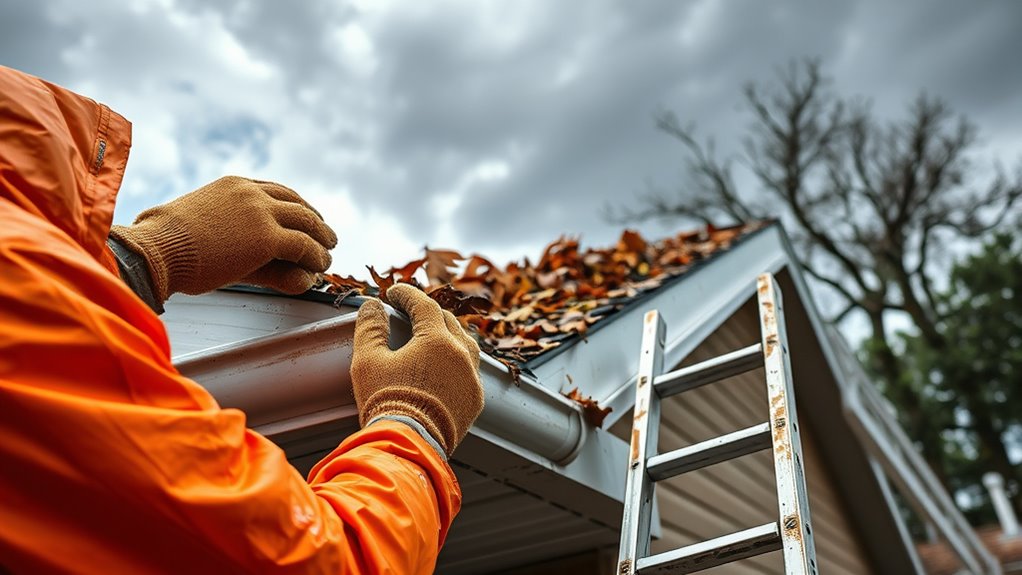
As heavy rains approach, it’s essential to inspect and clean your gutters to prevent water damage. Start with a thorough gutter inspection to identify any blockages or damage. Remove leaves, twigs, and other debris that can clog the system and hinder proper water flow. Clearing out debris ensures water moves freely through the gutters and downspouts, reducing the risk of overflowing or leaks. While inspecting, check for loose or damaged brackets and ensure the gutters are securely attached to your home. Regular maintenance now can save you costly repairs later. Don’t ignore small clogs or dirt—address them promptly. A clean, well-functioning gutter system directs water away from your home’s foundation, protecting your property during heavy rains. Incorporating routine inspections and AI-driven detection methods can help maintain optimal performance and prevent potential issues before they escalate.
Check and Repair Roofs and Shingles for Storm Damage
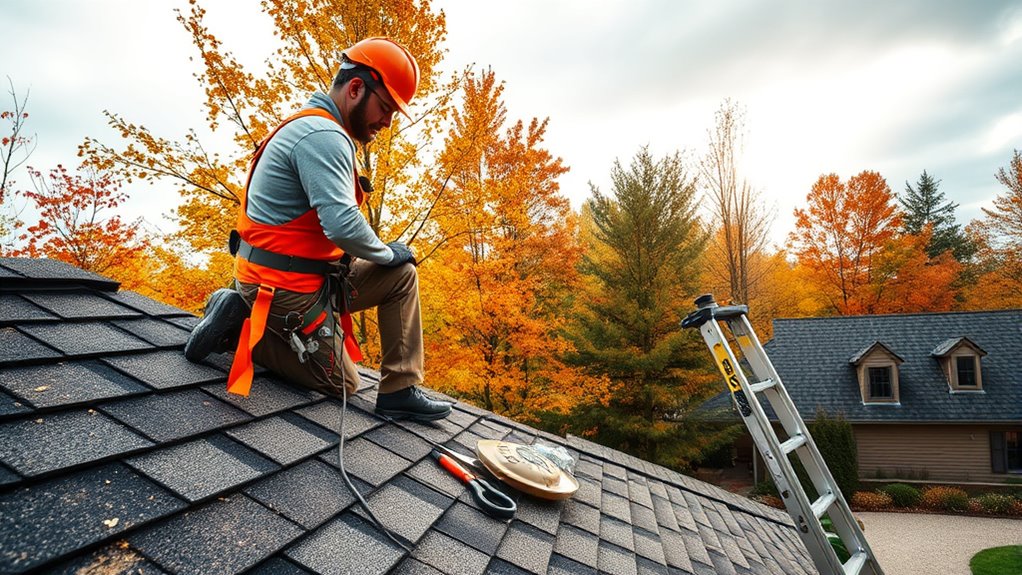
After cleaning and inspecting your gutters, it’s time to turn your attention to the roof. Start with a thorough roof inspection to identify any storm damage, such as missing or curled shingles. Look for loose or damaged shingles that could compromise your roof’s integrity. If you spot cracked or buckled shingles, perform shingle repair promptly to prevent leaks and further deterioration. Use binoculars or a ladder to examine hard-to-see areas, but stay safe and avoid walking on damaged sections. Addressing storm damage early helps maintain your roof’s strength and prevents costly repairs down the line. Regular roof inspections and timely shingle repairs are essential steps to protect your home from leaks, water damage, and weather-related accidents. Incorporating roof maintenance into your seasonal home care routine ensures long-term durability and safety. Additionally, understanding the architectural styles of your roof can help you identify specific repair needs based on the design and materials used. Regular inspections also allow you to spot potential issues early, reducing the likelihood of major repairs later. Recognizing signs of damage early can also help prevent structural problems that may develop over time.
Clear Pathways and Driveways of Debris and Obstructions
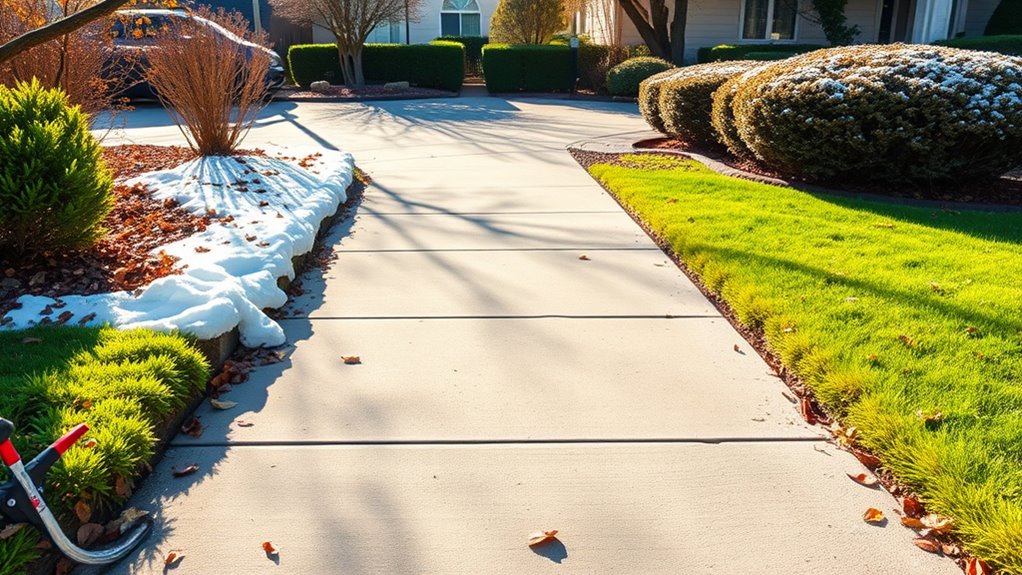
Make sure your pathways and driveways are free of fallen leaves, snow, and ice to keep them safe and accessible. Clearing debris now prevents slips and damage when winter weather hits. Taking these quick steps helps you maintain a tidy and secure entryway year-round. Regularly inspecting your surfaces for exfoliation and removal of dead skin cells can also help preserve their condition and prevent accidents. Additionally, maintaining the integrity of your surfaces by addressing surface degradation can extend their lifespan and safety.
Remove Fallen Leaves
Have fallen leaves cluttering your pathways and driveways become a hassle? Regular leaf pile removal is essential for yard cleanup and safety. Clearing leaves prevents slips, falls, and hidden obstructions. Use a rake or leaf blower to gather debris efficiently. Focus on high-traffic areas like walkways and driveways to maintain safe access. Schedule leaf removal frequently during peak fall to prevent buildup. Keep tools ready and work in manageable sections. Proper lighting can also improve visibility during cleanup, especially in early morning or late evening hours. Additionally, understanding the types and varieties of leaves can help you determine the best disposal method for your yard waste. Recognizing leaf decomposition rates can assist in planning your cleanup schedule effectively. Proper disposal methods can also reduce the risk of fire hazards during dry seasons. Below is a helpful chart to guide your yard cleanup:
| Task | Tips |
|---|---|
| Raking Leaves | Rake when leaves are dry for easier collection |
| Leaf Blower Usage | Use a blower for quick cleanup |
| Disposal | Compost or bag leaves for removal |
| Safety Precautions | Watch for hidden hazards under leaves |
| Frequency | Clear leaves weekly during heavy fall |
Clear Snow and Ice
Clearing snow and ice from your pathways and driveways is essential for safety and accessibility during winter months. To do this effectively, follow these steps:
- Use a sturdy snow shovel to remove fresh snow, creating a clear walkway.
- De-ice sidewalks with ice melt or sand to prevent slips.
- Salt driveways to melt stubborn ice and improve traction.
- Keep a broom handy to sweep away remaining ice patches or debris.
Service HVAC Systems for Efficient Heating and Cooling
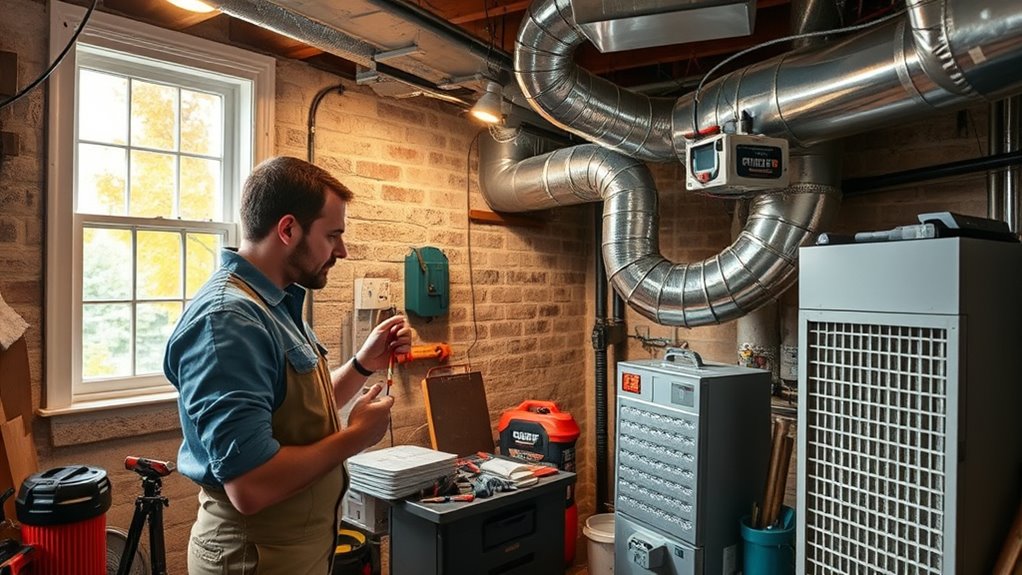
Ever wonder if your HVAC system is running as efficiently as it should? Regular service can make a big difference. Start by checking the thermostat calibration to ensure your system responds correctly to temperature settings. An inaccurate thermostat can cause your system to work harder than necessary, wasting energy and increasing costs. Additionally, schedule duct cleaning to remove dust, debris, and obstructions that restrict airflow. Clean ducts improve indoor air quality and help your heating and cooling systems operate smoothly. Don’t forget to inspect filters and replace them if dirty. Proper maintenance keeps your HVAC running efficiently, saves money, and extends its lifespan. Regularly monitoring system performance can help catch potential issues early before they lead to costly repairs. Also, consider inspecting the filtration system, including HEPA filters, to ensure optimal air quality and system efficiency. For homes in coastal areas, especially, inspecting for signs of corrosion and addressing salt buildup is crucial to prevent system damage. In addition, upgrading to energy-efficient components can further improve your system’s performance and reduce operational costs. Incorporating preventive maintenance practices is essential for maintaining overall system health and avoiding unexpected breakdowns. Addressing these tasks before peak seasons ensures comfort and reduces the risk of unexpected breakdowns.
Seal Windows and Doors to Prevent Drafts and Water Intrusion

Sealing your windows and doors is a simple but effective way to prevent drafts and water from entering your home. Start by inspecting your window insulation for gaps or cracks, then apply weatherstripping around the edges of your doors. Imagine:
- Running your hand along the window frame, feeling for cold air leaks.
- Pulling back old, worn weatherstripping from your doorframe.
- Carefully sealing gaps with new, adhesive-backed weatherstripping or caulk.
- Checking the bottom of your doors for drafts and installing door sweep weatherstripping if needed.
These steps create a tight seal that keeps cold air and moisture out, helping your home stay warm and dry. Proper window insulation and door weatherstripping are key for seasonal comfort and water intrusion prevention.
Inspect and Maintain Outdoor Lighting for Darkness Visibility

As days grow shorter and evenings become darker, guaranteeing your outdoor lighting is functioning properly becomes essential for safety and visibility. Check all outdoor fixtures, including pathway lighting, to confirm they work correctly. Replace burnt-out bulbs and clean fixtures to improve illumination. Properly maintained outdoor lighting guides you safely around your property, reducing trip hazards. Regular outdoor lighting maintenance helps ensure your safety and visibility year-round, especially during seasonal changes that can affect lighting conditions. Additionally, verifying the trustworthiness of the brand of your outdoor lighting products can help prevent unexpected failures and ensure longevity.
Trim Tree Branches Near the Home to Avoid Falling Hazards
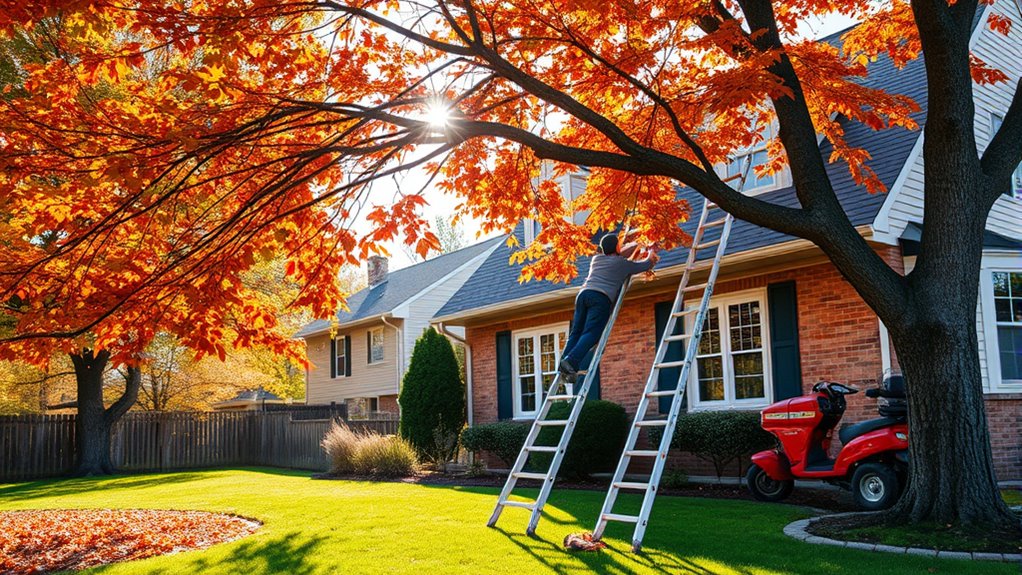
Proper outdoor lighting helps improve safety during nighttime, but overhanging tree branches can obstruct illumination and create hazards. To prevent falling accidents, you should regularly prune overhanging branches and remove dead limbs. Here’s what you should focus on:
- Visualize a branch heavy with leaves, threatening to fall during a storm.
- Imagine a dead limb hanging precariously, ready to break off unexpectedly.
- Picture a branch brushing against your roof, risking damage or entry points.
- Envision clearing away clutter and ensuring branches are well above walkways.
Prepare Emergency Kits and Supplies for Severe Weather

You should gather essential items like non-perishable food, water, and first aid supplies to be ready for severe weather. It’s also important to check that your emergency contacts are current and accessible. Finally, store important documents like IDs and insurance papers in a safe, easy-to-reach place.
Stockpile Essential Items
Have you prepared your emergency kits and supplies for severe weather? Stockpiling essential items is crucial for emergency preparedness and maintaining seasonal safety. Visualize opening your kit:
- Bottled water to stay hydrated during outages
- Non-perishable food for sustenance
- Flashlights with extra batteries for visibility
- First aid supplies to handle minor injuries
With these items ready, you ensure your family’s safety during storms or power failures. Keep supplies in an accessible, waterproof container, and check them regularly. Stockpiling minimizes chaos and helps you respond quickly when severe weather strikes. Remember, seasonal safety depends on proactive planning—being prepared can make all the difference in an emergency. By maintaining these essentials, you’re taking a vital step toward protecting your home and loved ones.
Check Emergency Communications
Ensuring your emergency communication plan is in place is essential for staying connected during severe weather. You should verify that all family members know how to reach each other and have updated contact information, including emergency contacts and local authorities. Test your emergency communication devices, such as cell phones, radios, or satellite phones, to confirm they work properly. Keep a list of contact information in your emergency kit, so you can quickly access it if needed. Consider having backup power sources like batteries or chargers to maintain communication during a power outage. Regularly review and update your contact details, especially if there are changes in your household or local emergency numbers. Staying prepared with reliable communication helps you coordinate quickly and stay safe during severe weather events.
Store Important Documents
Are your important documents ready and accessible in case severe weather strikes? Proper document organization guarantees you can quickly find what you need. Start by gathering essential papers like IDs, insurance policies, medical records, and property deeds. Store physical copies in a waterproof, fireproof container, and keep digital backups on a secure cloud service or USB drive. Visualize a safe, portable folder holding:
- Personal identification and passports
- Insurance policies and financial records
- Medical records and prescriptions
- Emergency contact lists and legal documents
Having these items ready minimizes stress during a crisis. Regularly update and review your stored documents to ensure everything is current. Digital backups add an extra layer of security, so you’re prepared no matter what severe weather brings.
Test Smoke and Carbon Monoxide Detectors Regularly

Regularly testing your smoke and carbon monoxide detectors is essential to guarantee they function properly when you need them most. Alarm testing ensures your detectors are working correctly, so you can trust them in an emergency. Make sure your detectors are properly placed; detectors should be installed on every level, outside sleeping areas, and in the kitchen. Proper detector placement maximizes coverage and early warning. During alarm testing, press the test button and listen for the alarm sound. If it doesn’t sound, replace the batteries or the unit itself. Avoid neglecting this simple task, as a malfunctioning detector could be the difference between safety and disaster. Schedule these tests monthly to keep your home’s safety system reliable and effective.
Drain and Store Outdoor Water Features to Prevent Freezing Damage
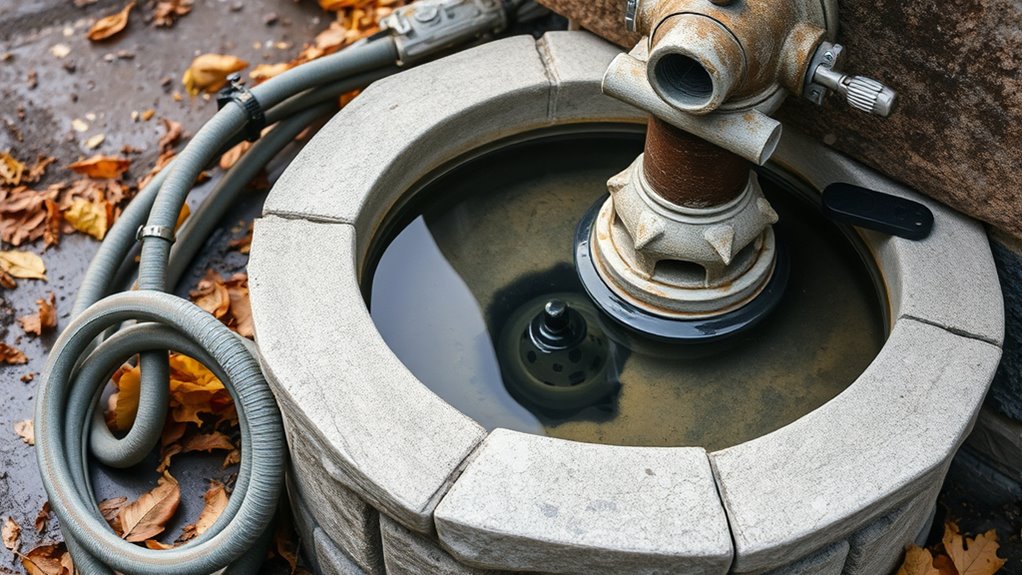
Before winter hits, make sure to drain all water from your outdoor features completely. Store pumps and other equipment securely to prevent damage, and cover everything to keep debris out. Taking these steps helps protect your water features from freezing and costly repairs.
Drain Water Completely
To prevent freezing damage, you need to drain all water from outdoor water features thoroughly. Leftover water can freeze, expand, and cause cracked pumps or frozen pipes, leading to water damage. Start by turning off the power supply to the feature. Then, follow these steps:
- Remove any pumps, filters, or hoses to access residual water.
- Tip or tilt the fountain or pond to drain remaining water completely.
- Use a wet/dry vacuum to suction out hidden pockets of water.
- Store removable parts indoors in a dry, protected area.
Store Equipment Securely
After draining your outdoor water features, make sure to store all equipment securely. Proper storage safety prevents accidents and extends the lifespan of your tools. Use a designated, organized space to keep hoses, pumps, and accessories out of the way. Coil hoses neatly to avoid tripping hazards and damage. Store small parts in labeled containers for easy access and to prevent loss. Ensuring equipment organization helps you find what you need quickly when spring arrives. Check that all items are dry before storing to prevent mold or rust. Keep heavy or sharp tools on lower shelves to avoid injury. By maintaining a tidy storage area, you reduce clutter and promote safety around your property during the off-season.
Protect With Covers
Protecting your outdoor water features from freezing damage is essential as temperatures drop. To prevent cracks and leaks, you should drain and store your water features properly. Start by removing all water and debris. Next,:
- Cover the fountain or pond with a sturdy seasonal cover option to shield it from snow and ice.
- Use insulated covers to help maintain a consistent temperature and prevent freezing.
- Secure covers tightly around the edges to keep out moisture and debris.
- Store smaller accessories indoors to avoid damage or loss during the winter months.
Frequently Asked Questions
How Often Should I Perform Seasonal Home Maintenance Tasks?
You should follow a seasonal checklist to stay on top of home maintenance tasks. Typically, you’ll want to review your maintenance schedule at the start of each season, like spring and fall, to guarantee safety. Regularly inspecting and caring for your home helps prevent accidents and costly repairs. By staying proactive and organized, you keep your home safe and well-maintained year-round, making it easier to spot issues early.
What Tools Are Essential for DIY Home Safety Inspections?
For DIY home safety inspections, you’ll need essential tools like a sturdy ladder to check high areas safely and a flashlight for better visibility. Don’t forget to perform fire alarm testing regularly—use the test button to verify they work properly. Keep a multi-tool or screwdriver handy for quick fixes. Prioritize ladder safety by inspecting your ladder for stability before use, and always follow safety guidelines to prevent accidents.
How Can I Identify Early Signs of Home Structural Issues?
To spot early signs of home structural issues, you should regularly inspect your home for foundation cracks and roof sagging. Look for cracks in basement walls or around windows, and note any uneven or drooping areas on your roof. These signs indicate underlying problems that need prompt attention. Addressing them early helps prevent costly repairs and guarantees your home’s safety and stability over time.
Are There Specific Safety Precautions for Outdoor Electrical Fixtures?
Ever think outdoor lighting is just a pretty feature? Think again. You need to prioritize electrical safety by ensuring fixtures are weatherproof and properly grounded. Always turn off power before maintenance, avoid overloading circuits, and use outdoor-rated bulbs and cords. Keep electrical fixtures away from water sources, and inspect for damage regularly. These precautions protect you from shocks or fires, proving that outdoor lighting isn’t just for looks, but for your safety too.
When Is the Best Time to Schedule Professional Home Inspections?
You should schedule a home inspection during seasonal planning, ideally in spring or fall when weather is milder. These periods allow professionals to thoroughly assess your home’s condition, identify potential issues, and recommend repairs before extreme weather hits. Regular inspections help prevent accidents by catching safety hazards early. Planning ahead guarantees you stay proactive, maintaining a safe, well-functioning home year-round.
Conclusion
By staying proactive with these seasonal maintenance tasks, you’ll create a safer, more comfortable home as the seasons change. Imagine your house standing strong against gusty winds and pouring rain, its gutters clear and roof solid. With a little effort now, you’ll sit back and enjoy cozy evenings inside, knowing you’ve prevented accidents before they happen. Keep your home protected—because a little prep goes a long way toward peace of mind.









